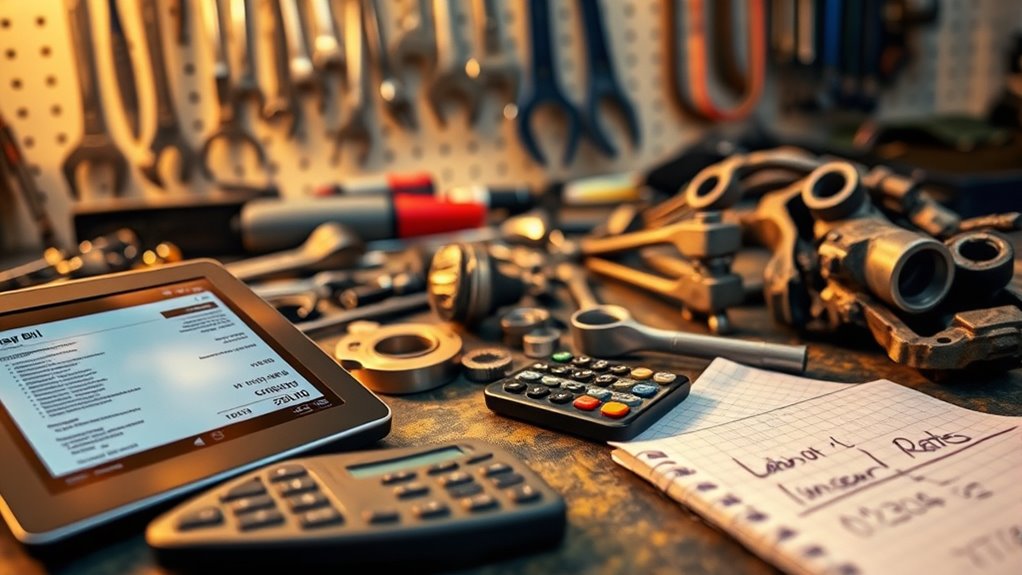Understanding mechanic labor rates helps you see what influences your repair bills. Rates are shaped by overhead costs like rent, technician wages, and location. More skilled mechanics charge higher rates, especially in urban areas. Complexity of repairs and market demand also play a role. Clear, transparent pricing often includes detailed estimates of labor hours and rates. Knowing these factors can help you compare quotes and avoid surprises—if you want to explore more, there’s plenty to learn about how these rates are calculated.
Key Takeaways
- Labor rates are influenced by overhead costs, technician wages, location, and repair complexity.
- Transparent pricing includes detailed breakdowns of labor hours and hourly rates for clarity.
- Shops often use fixed or flat-rate pricing based on estimated repair times to determine costs.
- Market demand and regional economic conditions cause labor rates to fluctuate over time.
- Understanding these factors helps consumers compare quotes and avoid unexpected charges.

Ever wonder how mechanic labor rates are determined? Understanding this can help you make better decisions when it’s time to get your vehicle repaired. At the core of it, mechanic labor rates are influenced by a mix of factors, but the process hinges on transparency and accurate labor cost calculation. When shops provide pricing transparency, they clearly break down what you’re paying for, helping you see how much of the bill is going toward labor versus parts or other fees. This openness makes it easier to compare different service providers and avoid surprises when you pick up your car.
Labor cost calculation is the foundation of mechanic labor rates. It involves figuring out how much a shop needs to charge per hour to cover expenses and still make a profit. Several elements play into this calculation. First, shops consider their overhead costs, such as rent, utilities, tools, and insurance. These expenses are divided across all the jobs they handle, so each repair includes a portion of these fixed costs. Then, they factor in the technician’s wages—more experienced mechanics typically command higher hourly rates because their skills can repair complex issues more efficiently. Additionally, the shop’s location influences rates; shops in urban areas with higher living costs tend to charge more than those in rural settings.
Labor costs cover overhead, technician wages, and location factors to set fair, transparent mechanic labor rates.
Many shops now emphasize pricing transparency, making it easier for customers to understand exactly what they’re paying for. When you’re provided with a detailed estimate, it should specify the labor hours needed for the repair and the hourly rate being charged. This way, you can see how the total labor cost is calculated and verify it against industry standards or other quotes. Some shops also offer flat-rate pricing, which is based on the estimated time to complete a specific repair. This system helps streamline labor cost calculation, providing a predictable rate and often speeding up the billing process. Furthermore, understanding the drivetrain components, such as the gears and derailleurs, can help you anticipate potential repair costs and labor requirements.
Keep in mind, though, that labor rates aren’t static. They can fluctuate based on the complexity of the repair, the skill level required, and even market demand. A simple oil change may have a lower labor rate, while an engine overhaul commands a higher one. By understanding how mechanic labor rates are determined and advocating for pricing transparency, you gain more control over your repair bills. You can ask detailed questions about how labor costs are calculated, compare quotes, and ensure you’re paying a fair price for quality work. Ultimately, knowledge of these factors helps you make smarter decisions and avoid inflated or confusing charges.
Frequently Asked Questions
How Do Mechanic Labor Rates Vary by Geographic Location?
You’ll notice mechanic labor rates differ based on your location, influenced by factors like pricing transparency and seasonal demand. In urban areas, rates tend to be higher due to higher living costs and more complex repairs. During busy seasons, prices may rise as shops capitalize on increased demand. Knowing these variations helps you budget better and compare shops, ensuring you get fair pricing regardless of where you’re located.
What Factors Influence Fluctuations in Mechanic Labor Rates?
You should know that fluctuations in mechanic labor rates are influenced by several factors. Pricing transparency plays a big role, as clear pricing can lead to more consistent rates. Additionally, mechanic experience impacts costs—more experienced mechanics often charge higher due to their expertise. Local demand and competition also affect rates, with busy areas typically having higher prices. All these elements together shape how much you’ll pay for repairs.
Are There Industry Standards for Mechanic Labor Rates?
Imagine walking into a busy garage, where labor rate transparency varies like shifting shadows. Industry standards do exist, guiding mechanics on fair pricing. These standards often align with mechanic certification standards, ensuring quality and fair wages. While rates can differ by region, these benchmarks help you compare costs confidently. Knowing about industry standards means you’re better equipped to spot fair pricing, making your repair experience straightforward and trustworthy.
How Can I Compare Mechanic Labor Rates Across Different Shops?
To compare mechanic labor rates across different shops, start by looking for pricing transparency on their websites or by asking directly. Research each shop’s reputation through reviews and recommendations, as reputable shops may charge slightly higher but offer better quality. Don’t just focus on the hourly rate; consider the overall value, including warranty, customer service, and experience, to guarantee you get the best deal for your repair needs.
Do Mechanic Labor Rates Include Parts and Additional Fees?
Many people assume mechanic labor rates include parts and fees, but that’s often not the case. Labor rates typically cover only the technician’s time, while parts markup and shop fees are added separately. You should ask shops if their quotes include parts markup or if extra shop fees apply. This way, you avoid surprises and compare prices accurately across different shops.
Conclusion
Now that you understand mechanic labor rates and repair bills, you’re better equipped to make informed decisions. You can ask smarter questions, compare estimates confidently, and avoid surprises. You can recognize value, appreciate transparency, and stand up for yourself. With knowledge, you gain confidence. With confidence, you gain control. So, take charge of your repairs, trust your understanding, and guarantee every dollar is well spent. Your car, your money, your peace of mind—protected through understanding.









